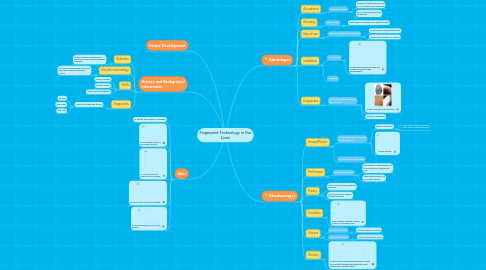
1. Advantages
1.1. Acceptance
1.1.1. Generally accepted
1.1.1.1. People are familiar with the use of it for identification purposes
1.1.1.2. One of the oldest biometric technology
1.2. Accuracy
1.2.1. High accuracy
1.2.1.1. Small chance of rejection of a legitimate print
1.3. Ease of use
1.3.1. Little time is required for enrolment
1.3.1.1. Do not require concentrated effort
1.3.1.2. Simply place a finger on a scanner
1.4. Installation
1.4.1. Easy to install
1.4.1.1. Fingerprint scanners are small and portable (Plug-and-play technologies)
1.4.2. Inexpesive
1.5. Uniqueness
1.5.1. An unique identifier specific to the individual
1.5.1.1. No two fingerprints are identical
1.5.1.2. Difficult to reproduce
2. Disadvantages
2.1. Groups/People
2.1.1. Some ethnic groups have lower quality fingerprints
2.1.1.1. Elderly populations
2.1.1.1.1. More difficult to be enrolled in some finger-scanning systems
2.1.1.2. Manual laborers
2.1.2. Not appropriate with children
2.2. Performace
2.2.1. Deterirorate over time
2.2.1.1. The fingerprint characteristics of an individual may change over time
2.2.1.2. Makes identification and verification difficult
2.3. Privacy
2.3.1. May be used to track a person’s activities
2.3.2. May be improperly used for forensic purposes
2.4. Condition
2.4.1. Make mistakes with the dryness or dirty of the finger’s skin
2.5. Process
2.5.1. Can easily be ruined
2.5.1.1. Become useless for testing
2.5.2. Complex and tedious
2.5.2.1. Hard to interpret the results
2.6. Security
2.6.1. Can be copied and reproduced easily by using some publicly available documentation and inexpensive materials (latex)
3. Future Development
4. History and Background Information
4.1. Definition
4.1.1. To use a person's fingerprints to identify him/her through fingerprint scanning
4.2. Biometric technology
4.2.1. The study of how people differ from each other based on biological factors
4.3. Fields
4.3.1. Security systems
4.3.2. Forensic science
4.3.3. Crime scene investigations
4.4. Fingerprints
4.4.1. Made up of ridges and furrows
4.4.1.1. 5% Arch
4.4.1.2. 30% Whorl
4.4.1.3. 65% Loop

